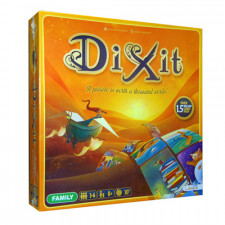Dixit Review
on Oct 4, 2015
Dixit is all about elucidating and deceiving. You want to clear everything up for some players while obscuring the true nature of your cards from others. But unlike team-based or traitor games, the precise individual who is actually deceived is much less important than the fact that someone is deceived.
Dixit consists of eighty-four cards, all of which display amazing artwork. And that’s it. There are no stats, no resource costs, no economic engines to build. It’s just a stack of picture cards. Each player gets a hand of six and players rotate being the clue-giver.
That person chooses a card in his hand and then describes it. But he can’t be too specific or too vague. He or she then places that card face down. Each other player selects a decoy card that could potentially match the description and throws it in. Then they are all shuffled and revealed. Players simultaneously select which card they believe is the clue-giver’s true card.
If everyone points to the clue-giver’s card (the hint was too obvious), then everyone but the clue-giver gets points. Similarly, if no one points to it (the hint was too vague), then everyone but the clue-giver gets points. The clue-giver only gets points if some, but not all opponents selected his card. A player also acquires points when other opponents erroneously select his decoy as the true card.
The challenge when playing Dixit is in giving just enough of a description of your chosen card. You have to come up with something that points toward your card, but gives enough space to allow decoy cards to be effective. Otherwise, your card is obvious and you’ll get no points. Knowledge of the deck and the potential cards that might be in other players’ hands is helpful, but not necessary. The only necessity is creativity and a willingness to be a little weird.
All of the artwork hits a whimsical note. You’ll see a rabbit dressed like a knight looking toward three doors. Or large raindrops with events occurring inside. Or even a heart and a feather on a scale. So the best clues tend to be about concepts or feelings. Manly men need not worry. You don’t actually have to feel those feelings, but you should at least be able to communicate them. After a few rounds, the game develops its own sense of poetry. Without really trying, you find yourself harkening back to high school literature class and finding words or concepts that you would only rarely have occasion to use in normal life.
And, taking just a step back from the game itself, the experience has a relatively unique beauty to it. While superficially similar to other, more mainstream games, Dixit is wholly distinct. In large part, that is due to the card art which is gorgeous and evocative. But more than just looking at pretty pictures, players are coaxed into taking a keen and critical eye to the artwork – which only enhances appreciation of the art and the game.
I don’t want to oversell it, though. You’re not likely to have an amazing epiphany or achieve a new philosophical realization. And, mechanically, there is one small drawback to the game – inside information. It’s possible to give a clue to your spouse and say, “Hey, remember when we took that trip last fall? Remember what we saw? Yeah. That.†Anyone not on that trip will have no idea what you’re talking about, which means you’ll stump some while ensuring that your spouse gets it right. That’s a cheesy and uninteresting way to play. So don’t do it. But the same is true of repeat Dixit players. Sometimes you come up with a great and memorable clue. Those moments are awesome! But then, the next game, maybe you want to use that same clue again. And you can – but only if there’s at least one new player. Otherwise, everyone remembers from the last game and they’ll all pick your card. For that reason, I tend to play Dixit only a few times each year, so that no meta develops.
Even so, Dixit is a fantastically unique experience. Every time I open the box I have a good time. And the artwork is absolutely fabulous. As you play, you feel like you are on a journey through a children’s book – or perhaps a beloved childhood film. Which isn’t to say it feels dumbed down or for kids. It definitely doesn’t. But it has that same feeling of discovery, journey, joy, and innocence that are generally absent from more mundane adult pursuits.

 Customer Support
Customer Support  Subscribe
Subscribe 




 Account
Account  Wishlist
Wishlist 

